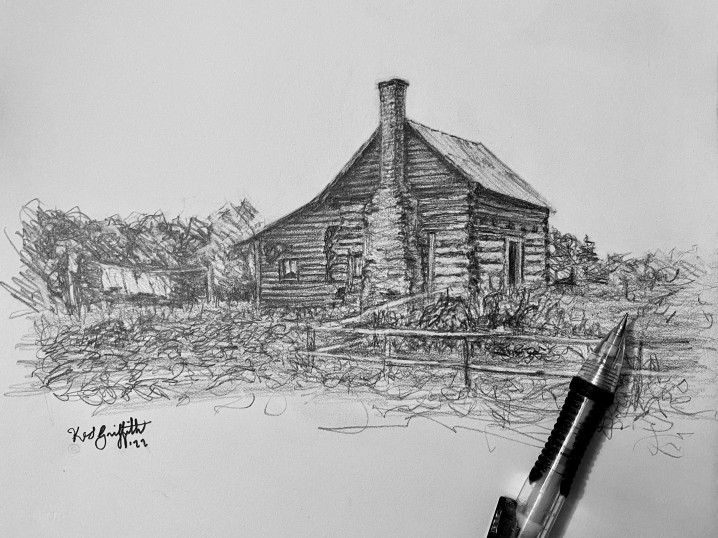
**This research was first published in the May 7, 2025 edition of the Chatham Star-Tribune newspaper as part of Kyle Griffith’s weekly segment entitled “Heritage Highlights.”
Old Country Homestead – Sketch by Kyle Griffith, 2022
Away from town, down long hilly roads, the trees conceal special pockets of land where time crawls by. Among the cows and farmland stand sudden reminders of history and the drastic changes in quality of life over the last few generations. Just one century ago it would not be out of place to saw down a clearing of trees, plow up a rocky field with a mule, build an entire chimney from fieldstones, and notch together a log cabin from rough hewn logs. Rural families connected heavily with nature and lived in homes directly made from the land and Earth around them. They were resourceful people, and their children and grandchildren often maintained that value. Especially during other hard times throughout the Great Depression and the Second World War, homes contained features that, for the most part, are no longer seen in new construction.
Spending time within old homes and experiencing their quirks develops an interesting relationship between the house and the occupant. If someone has only ever had new construction and up-to-date technology, then moving to an old country house may seem like a complete downgrade. However, those who grew up in old homes or inherited them somehow are sure to be charmed by the certain signs of age, resourcefulness, struggle, personality, and a lived-in spirit that make up a home’s life. As an ode to the nostalgia of old homes, the following details may evoke memories from certain homes from the past.
“At first glance, an old home may look like it was built by someone who did not own a level. Something amusing as a child on car rides was to see a big old house where the second story featured what seemed to be a “door to nowhere,” with a precarious drop down to the grass a whole story below, and the former porch nowhere to be found. If well preserved, the unmistakable wavy and bubbly glass panes are still secured in their muntins. Sometimes fake windows were built onto the house to replicate symmetry. Aged brick may feature fingerprints, lumpy and rocky clay, black marks, or a bluish-silver glazed surface which all tell that they were fired in a kiln that was probably close by. The front porch remains a place of cultural spirit in the countryside, many of which have since been screened-in, partially enclosed, or completely enclosed to expand the household. Some smaller cabins had shelving or simple nail-hung storage upon the exterior walls of their homes.
When entering an old home, the extent of a caretaker’s responsibility may become immediately clear. It constantly reminds people that while they may own the property, they were stewards of history, responsible for preserving the spirit of the home. The first steps into a house are sure to be met by the squeals of loose floorboards made from knotty and splintery lumber. Smoke stained kitchen ceilings tell of a lifetime of good eating over the wood stove. Some old homes patched the floors with tin cans or license plate metal. There may be steep, challenging stairs a few degrees removed from being a ladder with no safety banister. In the wintertime, many of the doors and windows will swell shut or no longer close. Upon closer inspection, some doors may be installed upside down, or little closet door handles may be revealed to actually be a painted corn cob or something makeshift. Old plaster walls might crumble and reveal a horse hair mixture, or old newspapers may reveal themselves being folded up to fill cracks in the floor.
A house may seem overgrown, dilapidated, or even “sigogglin,” but to someone they were once a place called home for years and years. Sometimes relatives are still living there after a handful of generations. As for others, not every historic house can be saved as they are all destined to give way to time eventually. With their awkward stairways, sneak-proof floors, and improvised updates, old country homes are treasures–organic structures in need of care and conservation.

